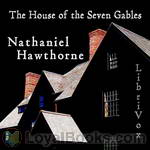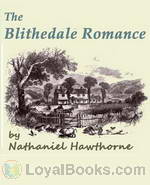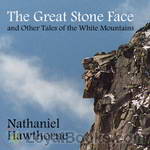|
Books Should Be Free Loyal Books Free Public Domain Audiobooks & eBook Downloads |
|
|
Books Should Be Free Loyal Books Free Public Domain Audiobooks & eBook Downloads |
|
Literature |
|---|
|
Book type:
Sort by:
View by:
|
By: Nathaniel Hawthorne | |
|---|---|
 The House of the Seven Gables
The House of the Seven Gables
“The wrongdoing of one generation lives into the successive ones and… becomes a pure and uncontrollable mischief.” Hawthorne’s moral for “The House of the Seven Gables,” taken from the Preface, accurately presages his story. The full weight of the gloomy mansion of the title seems to sit on the fortunes of the Pyncheon family. An ancestor took advantage of the Salem witch trials to wrest away the land whereon the house would be raised… but the land’s owner, about to be executed as a wizard, cursed the Pyncheon family until such time as they should make restitution... | |
 The Blithedale Romance
The Blithedale Romance
The Blithedale Romance is the story of four principal characters who work with -- and sometimes against -- each other on Blithedale, a communal farm antecedent to those that sprang up later in the 1960s, and similar to one on which Hawthorne himself lived in 1841. These communes arose out of the pressures on society and the individual brought by the Industrial Revolution. Some were organized around religious philosophies, some were secular. Among the secularists, the Transcendental movement mentioned in the novel espoused the idea that the individual's intuition, rather than religious dogma, was the true path to spiritual enlightenment... | |
 The Great Stone Face and Other Tales of the White Mountains
The Great Stone Face and Other Tales of the White Mountains
A collection of four short stories by Nathaniel Hawthorne, the common theme of which is New Hampshire's White Mountains. Consists of: The Great Stone Face, written in 1850 and revolves around the 'Old Man of the Mountain (Cannon Mtn.) in New Hampshire which sadly collapsed on May 3, 2003; The Ambitious Guest, written in 1835; The Great Carbuncle, written in 1837; and Sketches From Memory, written sometime prior to The Great Carbuncle as will become obvious. | |
 The Marble Faun
The Marble Faun
The Marble Faun is Hawthorne's most unusual romance. Writing on the eve of the American Civil War, Hawthorne set his story in a fantastical Italy. The romance mixes elements of a fable, pastoral, gothic novel, and travel guide. In the spring of 1858, Hawthorne was inspired to write his romance when he saw the Faun of Praxiteles in a Roman sculpture gallery. The theme, characteristic of Hawthorne, is guilt and the Fall of Man. The four main characters are Miriam, a beautiful painter who is compared... | |
 The Great English Short-Story Writers, Volume 1
The Great English Short-Story Writers, Volume 1
| |
 Mosses from an Old Manse and other stories
Mosses from an Old Manse and other stories
| |
 From Twice Told Tales
From Twice Told Tales
| |
 The Snow Image and other stories
The Snow Image and other stories
| |
 John Inglefield's Thanksgiving (From: "The Snow Image and Other Twice-Told Tales")
John Inglefield's Thanksgiving (From: "The Snow Image and Other Twice-Told Tales")
| |
 The Snow-Image A Childish Miracle
The Snow-Image A Childish Miracle
| |
 The Old Manse (From "Mosses from an Old Manse")
The Old Manse (From "Mosses from an Old Manse")
| |
 The Wives of the Dead (From: "The Snow Image and Other Twice-Told Tales")
The Wives of the Dead (From: "The Snow Image and Other Twice-Told Tales")
| |
 The Christmas Banquet (From "Mosses from an Old Manse")
The Christmas Banquet (From "Mosses from an Old Manse")
| |
 Septimius Felton, or, the Elixir of Life
Septimius Felton, or, the Elixir of Life
| |
 Main Street (From: "The Snow Image and Other Twice-Told Tales")
Main Street (From: "The Snow Image and Other Twice-Told Tales")
| |
 Buds and Bird Voices (From "Mosses from an Old Manse")
Buds and Bird Voices (From "Mosses from an Old Manse")
| |
 The Man of Adamant (From: "The Snow Image and Other Twice-Told Tales")
The Man of Adamant (From: "The Snow Image and Other Twice-Told Tales")
| |
 A Bell's Biography
A Bell's Biography
| |
 The New Adam and Eve (From "Mosses from an Old Manse")
The New Adam and Eve (From "Mosses from an Old Manse")
| |
 Sunday at Home (From "Twice Told Tales")
Sunday at Home (From "Twice Told Tales")
| |
 The Hall of Fantasy (From "Mosses from an Old Manse")
The Hall of Fantasy (From "Mosses from an Old Manse")
| |
 A Virtuoso's Collection (From "Mosses from an Old Manse")
A Virtuoso's Collection (From "Mosses from an Old Manse")
| |
 P.'s Correspondence (From "Mosses from an Old Manse")
P.'s Correspondence (From "Mosses from an Old Manse")
| |
 Little Daffydowndilly (From: "The Snow Image and Other Twice-Told Tales")
Little Daffydowndilly (From: "The Snow Image and Other Twice-Told Tales")
| |
 A Book of Autographs
A Book of Autographs
| |
 A Select Party
A Select Party
| |
 Old Ticonderoga, a Picture of the Past (From: "The Snow Image and Other Twice-Told Tales")
Old Ticonderoga, a Picture of the Past (From: "The Snow Image and Other Twice-Told Tales")
| |
 A Rill from the Town Pump
A Rill from the Town Pump
| |
 Fire Worship (From "Mosses from an Old Manse")
Fire Worship (From "Mosses from an Old Manse")
| |
 The Old Apple Dealer (From "Mosses from an Old Manse")
The Old Apple Dealer (From "Mosses from an Old Manse")
| |
 Sylph Etherege (From: "The Snow Image and Other Twice-Told Tales")
Sylph Etherege (From: "The Snow Image and Other Twice-Told Tales")
| |
 Old News (From: "The Snow Image and Other Twice-Told Tales")
Old News (From: "The Snow Image and Other Twice-Told Tales")
| |